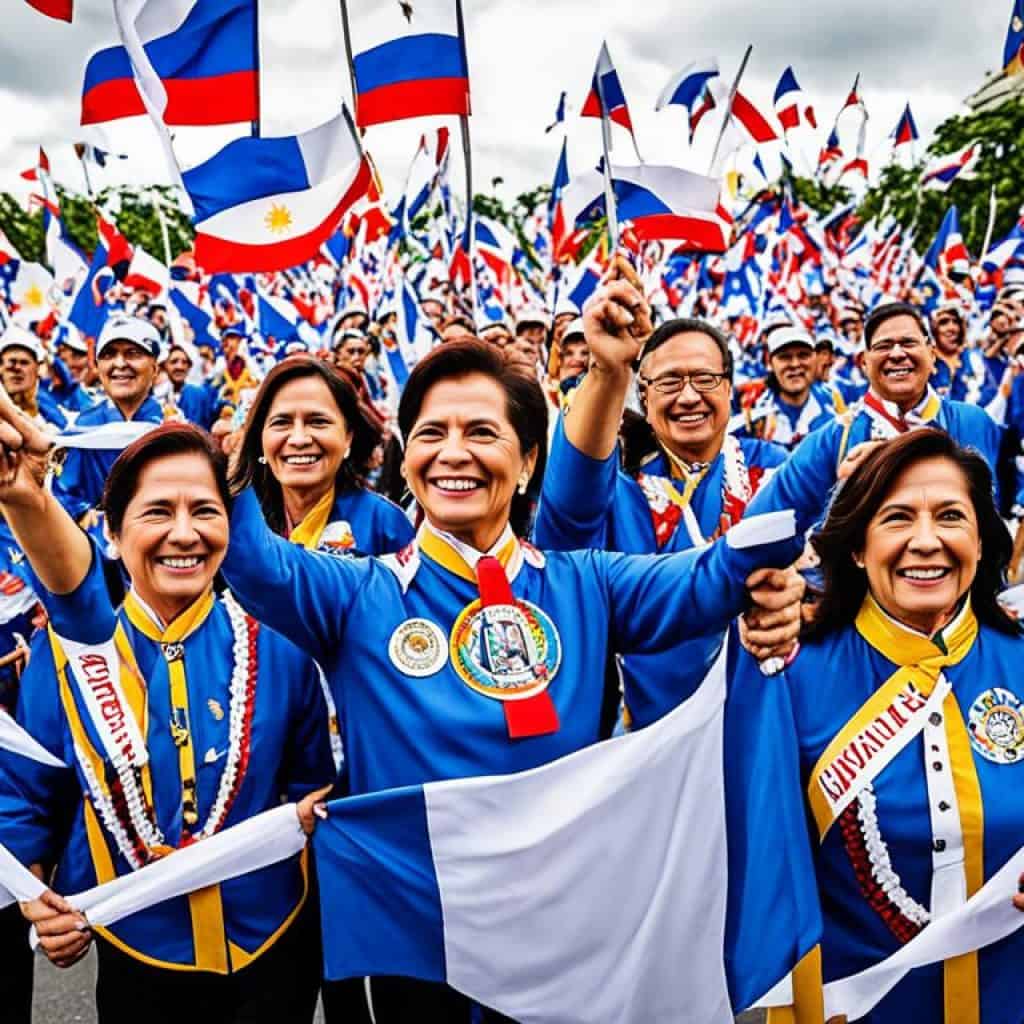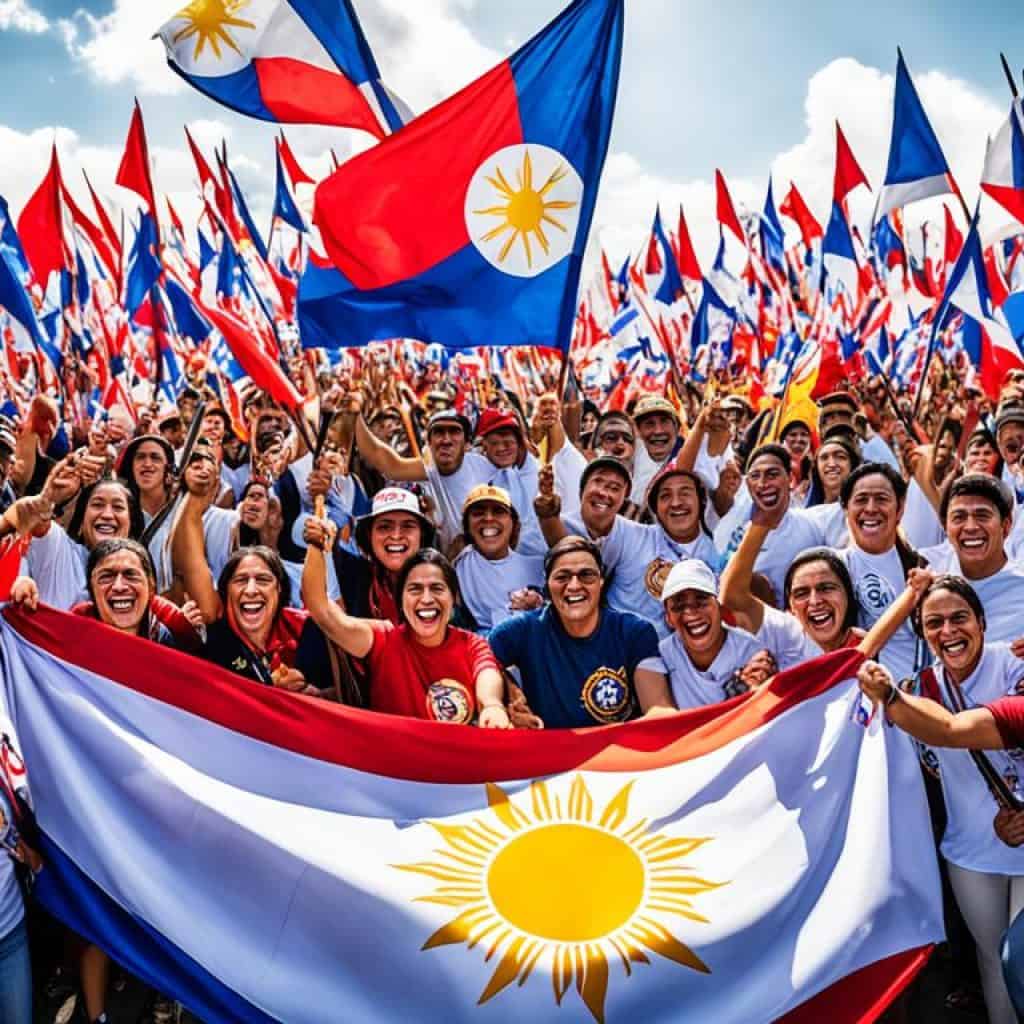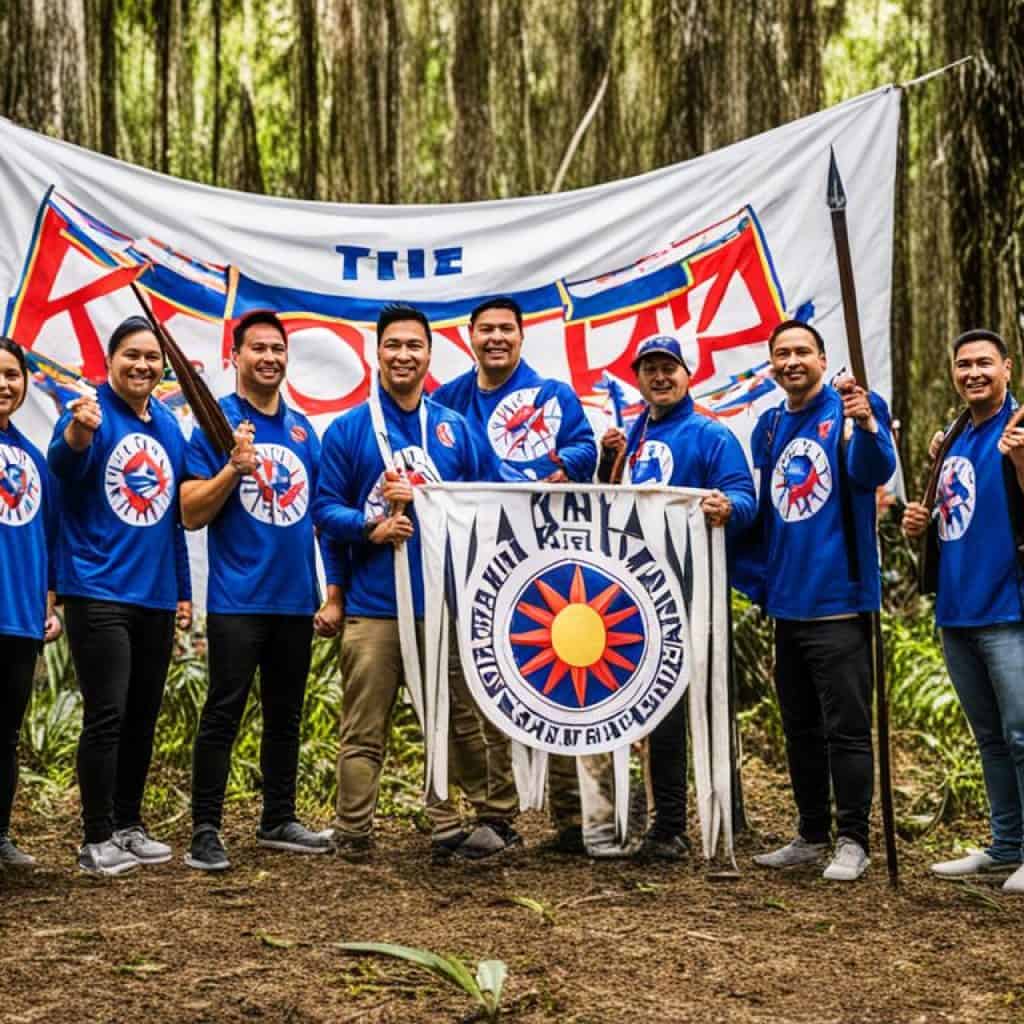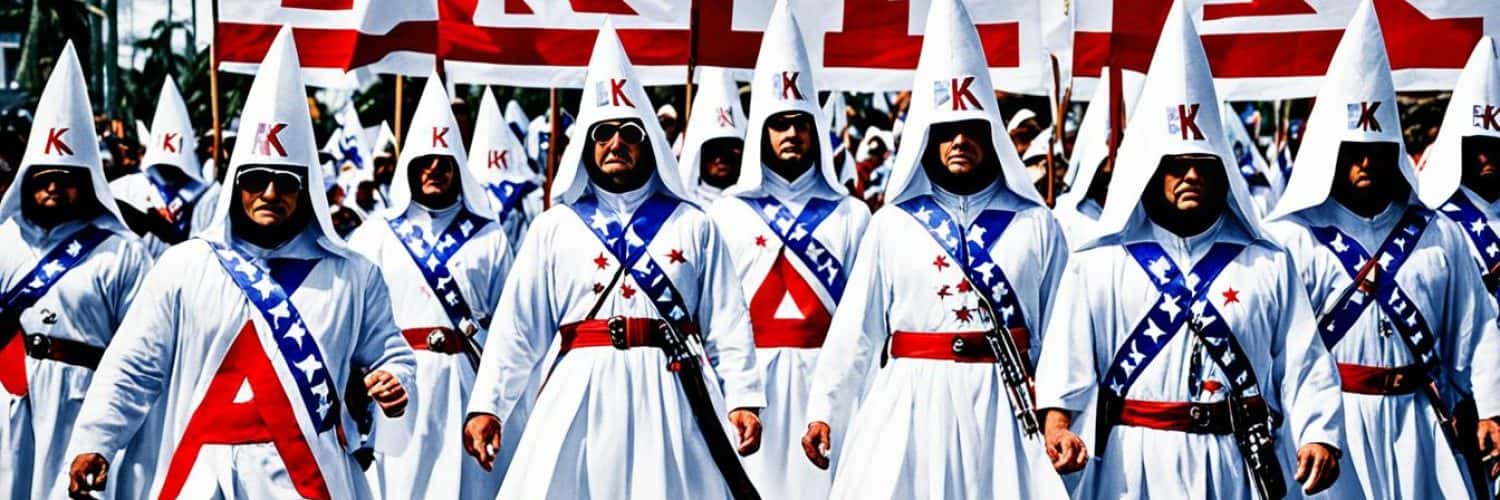When you hear the initials KKK, what comes to mind? Many people associate these letters with the notorious Ku Klux Klan, a hate group that spread terror in the United States. But did you know that in the context of the Philippines, KKK has an entirely different meaning? In this article, we will delve into the history and significance of the KKK in the Philippines, shedding light on a lesser-known chapter of Filipino nationalism and revolution.
Key Takeaways:
- The KKK, or Katipunan, was a revolutionary organization founded in the Philippines in 1892.
- Its primary objective was achieving independence from the Spanish Empire through armed revolution.
- The KKK played a pivotal role in the Philippines’ quest for independence and the start of the Philippine Revolution.
- The KKK’s actions and sacrifices laid the groundwork for the eventual establishment of an independent Philippines.
- Stay tuned to discover the history, objectives, leadership, and impact of the Philippine KKK movement.
History of KKK in the Philippines
The Katipunan, also known as the KKK, was formed in July 1892 as a response to the arrest and deportation of Filipino nationalist José Rizal. Led by prominent figures such as Andrés Bonifacio, Deodato Arellano, and Teodoro Plata, the Katipunan aimed to achieve representation and independence for Filipinos through armed revolution.
This secret society operated clandestinely, carrying out its activities in pursuit of their revolutionary ideals. The Katipunan’s formation coincided with the establishment of the short-lived publication called Kalayaan, or “Freedom.” Through this publication, the society spread their message and inspired fellow Filipinos to join their cause.
Driven by a strong determination to free the Philippines from Spanish rule, the Katipunan’s influence grew rapidly. Their revolutionary fervor ultimately culminated in the declaration of independence on June 12, 1898, marking a significant milestone in the country’s history.
This image offers a visual representation of the historical context of the KKK in the Philippines, emphasizing its impact on the nation’s struggle for independence. The image captures the spirit of revolution and resilience that defined this pivotal period in Philippine history.
KKK’s Objectives and Significance
The Katipunan, also known as the KKK, had a clear objective in Filipino history – to gain independence from the Spanish Empire through armed revolution. The society sought to unite Filipinos and inspire them to fight for their rights and freedom. Its significance cannot be overstated, as the Katipunan played a pivotal role in mobilizing and organizing the Filipino people, setting the stage for the start of the Philippine Revolution.
The Katipunan’s actions and sacrifices were instrumental in laying the groundwork for the eventual establishment of an independent Philippines. By galvanizing the Filipino population, the society ignited the spirit of resistance against Spanish rule and paved the way for the country’s journey towards self-determination.
Katipunan’s Founders and Leadership
The Katipunan, also known as the KKK, was founded by a group of Filipino nationalists who played instrumental roles in the organization’s formation and the planning of the revolution. The key leaders of the Katipunan were Andrés Bonifacio, Deodato Arellano, and Teodoro Plata.
Andrés Bonifacio, in particular, emerged as the leader of the Katipunan and played a crucial role in leading the society’s revolutionary activities and inspiring its members. His charismatic leadership and unwavering commitment to the cause motivated countless Filipinos to join the fight for independence.
“The love of country is never extinguished as long as there remains a single Filipino willing to die for it.” – Andrés Bonifacio
Under Bonifacio’s guidance, the Katipunan grew in strength and influence, organizing secret meetings, recruiting members, and planning revolutionary strategies. His leadership skills and dedication to the cause made him a cherished figure among the members of the society.
As the founder and leader of the Katipunan, Andrés Bonifacio played a pivotal role in shaping the course of Filipino history and laying the foundation for the Philippine Revolution. His legacy continues to inspire Filipinos to fight for their rights and strive for a better future.

Key Leaders of the Katipunan
| Leaders | Role |
|---|---|
| Andrés Bonifacio | Founder and Leader |
| Deodato Arellano | Founding Member |
| Teodoro Plata | Founding Member |
Katipunan’s Organizational Structure and Initiations
The Katipunan, inspired by freemasonry, implemented an organized hierarchical structure and initiation rites to unite its members and strengthen their loyalty to the society’s cause.
Initially, the Katipunan was a male-only society, but it later opened its doors to women members, recognizing their invaluable contributions to the revolutionary movement.
At the core of the organization was the Supreme Council, led by a president, secretary, treasurer, and fiscal. This council oversaw the overall operations and decision-making processes of the Katipunan.
Furthermore, the Katipunan established provincial councils in each province and popular councils in every town, creating a network of local leadership and ensuring efficient coordination of activities across the Philippines.
The initiation process for new members involved elaborate rites and ceremonies. These rituals not only served as a formal introduction but also instilled a sense of unity and commitment to the Katipunan’s cause.
Through the organizational structure and initiation rites, the Katipunan fostered a strong bond among its members, enabling them to work collectively towards their shared goal of independence.
“The unity and loyalty among Katipunan members were vital in driving the Philippine Revolution forward.”
Katipunan’s Publication and Literary Contributions
The Katipunan, in addition to its revolutionary activities, made significant contributions to Filipino literature through its publication called Kalayaan (Freedom). Kalayaan was established in March 1896 and served as a vital platform for the dissemination of revolutionary ideals and literature.
Prominent members of the Katipunan, including its founder Andrés Bonifacio, contributed their writings to Kalayaan, using the power of words to galvanize support for the revolution and inspire nationalistic sentiments among Filipinos. These literary works played a crucial role in uniting the Filipino people and fostering a sense of identity and purpose.
The Kalayaan publication featured poetry, essays, and articles that highlighted the struggles of the Filipino people under Spanish rule and advocated for independence. It served as a powerful medium for expressing the collective aspirations and grievances of the Filipino nation.
“Our pen will be the weapon that we will use in the struggle for our rights. Through our writings, we shall mobilize the hearts and minds of our fellow Filipinos, and ignite the flames of revolution.”
– Andrés Bonifacio
Through literary contributions, the Katipunan expanded the Filipino literary landscape and paved the way for future writers and artists to explore themes of nationalism, freedom, and identity. The works published in Kalayaan continue to be revered as important pieces of Philippine literature, representing the spirit of the revolution and the indomitable will of the Filipino people.
Selected Works of Kalayaan Publication
| Title | Author | Genre |
|---|---|---|
| “Sa Mga Kababaihang Taga-Malolos” | Marcelo H. del Pilar | Essay |
| “Pag-ibig sa Tinubuang Lupa” | Andrés Bonifacio | Poetry |
| “Ang Dapat Mabatid ng Tagalog” | Emilio Jacinto | Essay |
| “Ang Tigmamahal sa Bayan” | Julian Felipe | Poetry |
| “Ang Pagsilang ng Bagong Pilipino” | Pio Valenzuela | Essay |
Katipunan’s Plans for Revolution
The Katipunan, also known as the KKK, was founded with the ambitious goal of achieving independence from Spanish rule through armed revolution. The society had a well-thought-out plan for the revolution, which involved various strategic elements.
One crucial aspect of the Katipunan’s plan was to stockpile weapons and ammunition. This was done to ensure that the organization had the necessary means to fight against the Spanish forces and defend themselves effectively. By amassing weapons, the Katipunan aimed to establish a capable and armed resistance.
In addition to gathering arms, the Katipunan sought support from Filipino intellectuals who shared their revolutionary ideals. The society recognized the importance of intellectual and philosophical guidance in their pursuit of independence. They believed that the guidance of influential thinkers and visionaries could inspire and galvanize the masses.
“The philosopher must be a category of the society’s membership, for his wisdom and insight shall lead us to freedom.” – Andrés Bonifacio
The Katipunan’s leader, Andrés Bonifacio, played a crucial role in seeking the support of renowned Filipino philosopher and national hero, José Rizal. However, Rizal, though sympathetic to the cause of independence, hesitated to join the armed uprising. Despite Bonifacio’s efforts, Rizal believed that achieving national progress through education and reform should be the priority.
Undeterred, the Katipunan explored alternative avenues to secure arms for the revolution. One notable attempt was in 1896 when the society attempted to acquire firearms from a visiting Japanese warship. Unfortunately, this plan did not materialize, and the Katipunan had to explore other means to obtain the necessary weaponry.
Katipunan’s Plans for Revolution
| Components of the Plan | Description |
|---|---|
| Stockpiling of Weapons | The Katipunan aimed to gather sufficient arms and ammunition to equip their members and establish a capable resistance against the Spanish forces. |
| Seeking Support from Intellectuals | The society recognized the importance of intellectual guidance and sought the support of influential Filipino thinkers to inspire and provide direction to their movement. |
| Engaging José Rizal | Andrés Bonifacio sought the support of José Rizal, a widely respected philosopher and national hero. Although Rizal sympathized with the cause, he believed in achieving progress through education and reform rather than armed revolution. |
| Attempt to Secure Arms from Japanese Warship | In 1896, the Katipunan made an unsuccessful attempt to acquire firearms from a visiting Japanese warship, forcing them to explore other means to obtain necessary weaponry. |
Despite the setbacks, the Katipunan remained steadfast and determined in their commitment to achieving Philippine independence. The society persisted in their revolutionary efforts and would ultimately play a significant role in the Philippine Revolution.
Continue reading to discover the events that led to the discovery of the Katipunan and the declaration of war against the Spanish government.
Discovery and Declaration of War
In August 1896, the Katipunan’s existence and its revolutionary activities were discovered by Spanish authorities in Manila, Philippines. This discovery marked a turning point in the country’s history and ignited the flames of the Philippine Revolution. Under the leadership of Andrés Bonifacio, the Katipunan openly declared war against the Spanish government, signaling a bold and decisive step towards independence.
The declaration of war by the Katipunan paved the way for a three-year-long revolution, with fierce battles fought across Manila and its neighboring provinces. The Filipino revolutionaries, driven by a burning desire for freedom, exhibited immense bravery and resilience in the face of a powerful colonial force.
The discovery of the Katipunan and the subsequent declaration of war against the Spanish government marked a critical moment in Philippine history. It was a declaration of the Filipino people’s unwavering determination to fight for their rights and independence.
The Philippine Revolution: A Struggle for Freedom
The Philippine Revolution, sparked by the discovery of the Katipunan and its declaration of war, was a testament to the indomitable spirit of the Filipino people. The revolutionaries fought valiantly for their freedom, facing countless challenges and sacrifices along the way.
The battles waged during the revolution were not confined to military clashes alone. The Filipino revolutionaries also fought against the deeply entrenched social inequalities and injustices perpetuated by Spanish colonial rule. Their struggle was a multifaceted fight for self-determination, equality, and the restoration of Filipino pride and identity.
“The revolution is not just the taking up of arms; it is the awakening of the collective consciousness of a people, a realization that they possess the power to shape their destiny.” – Andrés Bonifacio
The Legacy of the Katipunan
The Katipunan’s discovery and subsequent declaration of war against the Spanish government set in motion a series of events that would ultimately lead to the Philippines’ independence. The sacrifices and bravery of the revolutionaries continue to inspire generations of Filipinos to this day, serving as a reminder of the unwavering spirit and resilience of the Filipino people.
| Key Events | Significance |
|---|---|
| Discovery of the Katipunan | Marked the beginning of the Philippine Revolution and the Filipino people’s open defiance against Spanish colonial rule. |
| Declaration of War | Symbolized the Filipinos’ determination to fight for their rights, freedom, and independence. |
| Three-Year Revolution | Highlighted the resilience and bravery of the Filipino revolutionaries in the face of a well-equipped and formidable colonial force. |
| Legacy of the Katipunan | Inspired future generations of Filipinos to continue the fight for freedom and self-determination. |
The legacy of the Katipunan serves as a reminder of the power of unity, sacrifice, and the unwavering spirit of the Filipino people in the pursuit of independence.
Etymology of Katipunan
The name “Katipunan” is derived from the Tagalog word “katipon” or “to gather.” It symbolizes the association, gathering, or group formed by Filipinos united in their mission for independence.
The official name of the society, Kataastaasan, Kagalanggalangang Katipunan ng mga Anak ng Bayan, translates to the Supreme and Most Honorable Society of the Children of the Nation.
Katipunan Etymology: Understanding the Meaning
The word “Katipunan” holds significant meaning in Filipino history. It represents the unity and collective spirit of the Filipinos who came together to fight for their independence from Spanish rule.
“Katipon,” the root word, signifies the act of gathering and joining forces. This emphasizes the powerful bond formed by the members of the society as they rallied behind a common cause.
The Katipunan was not just an organization; it was a symbol of national pride, courage, and determination. Its name, Kataastaasan, Kagalanggalangang Katipunan ng mga Anak ng Bayan, further exemplifies its noble purpose and the respect bestowed upon its members.
“The name ‘Katipunan’ represents the strength of the Filipino people united in their fight for independence.”
The Katipunan’s Role in the Independence Process
The Katipunan played a crucial role in the Philippines’ quest for independence from Spanish rule. Through its revolutionary activities, the society mobilized, organized, and inspired Filipinos to fight for their rights and freedom.
Under the leadership of Andrés Bonifacio, the Katipunan paved the way for the start of the Philippine Revolution. Their actions weakened the Spanish colonial power and galvanized the Filipino people towards the goal of independence.
The sacrifices and determination of the Katipunan eventually led to the declaration of Philippine independence on June 12, 1898. This marked a significant milestone in the history of the Philippines and laid the foundation for the nation’s future development and growth.
“The Katipunan’s unwavering commitment to freedom and self-determination resonates to this day, reminding us of the strength and resilience of the Filipino spirit.” – Emilio Aguinaldo
The Katipunan’s contribution to the Philippine Revolution cannot be overstated. Their efforts brought about a fundamental shift in the Filipino mindset, instilling a sense of national identity and aspiration for independence.
The Katipunan’s Influence on the Philippine Revolution
The Katipunan’s fervent nationalism and organized resistance inspired Filipinos from all walks of life to join the cause of independence. The society’s networks and underground activities facilitated the coordination of revolutionary efforts and intensified the struggle against Spanish domination.
List of Filipino Independence Leaders:
| Andrés Bonifacio | Emilio Aguinaldo | Apolinario Mabini |
|---|---|---|
| One of the founding members of the Katipunan and a key figure in the revolution. | Became the first president of the Philippines and played a crucial role in the struggle for independence. | Served as the revolutionary government’s chief adviser and played a significant role in drafting the constitution. |
 |
The Katipunan’s role in the independence process was not limited to armed struggle alone. They also spread revolutionary ideals through literature and education, fueling the spirit of resistance and unity among Filipinos.
The legacy of the Katipunan continues to inspire generations of Filipinos, reminding them of their history and the importance of fighting for freedom and justice.
The Filipino KKK Movement and Jose Rizal
Although José Rizal was not formally a member of the Katipunan, he remained closely affiliated with the society and its ideals. Rizal, a Filipino national hero, had been a member of the La Liga Filipina, an organization that aimed for Filipino representation in the Spanish Parliament. When the La Liga was shut down, many members, including Rizal, joined the Katipunan, whose goals had shifted towards armed revolution. Rizal’s execution by the Spanish authorities further fueled the Katipunan’s revolutionary spirit and determination.

The connection between José Rizal and the Katipunan played a significant role in the history of the Filipino KKK movement. While Rizal’s involvement was indirect, his ideals and sacrifices resonated with the members of the Katipunan, spurring them on in their quest for independence. Rizal’s execution served as a rallying cry for the revolutionaries, reinforcing their commitment to the cause and galvanizing their determination to fight for freedom.
“The indomitable spirit of José Rizal lives within us. His martyrdom unites us, fuels our desire for independence, and strengthens our resolve to stand against oppression.”
– Katipunan member
The Alleged Filipino KKK Branch in Hawaii
In 1922, rumors circulated about the existence of a Filipino branch of the Ku Klux Klan (KKK) operating in Hawaii. These rumors originated from investigations into labor disputes and alleged extortion incidents. However, it is important to note that these rumors were unfounded, and no such Filipino KKK branch actually existed.
These rumors likely arose from misconceptions and racial prejudices that were prevalent against the Filipino community at the time. The Filipino community in Hawaii faced discrimination and unfair treatment, which led to the spread of untrue rumors and stereotypes.
It is crucial to approach historical claims with critical thinking and to verify information from credible sources. In this case, the alleged Filipino KKK in Hawaii was a product of misinformation and biases, rather than a reality.
Rumors vs. Historical Facts
“The alleged presence of a Filipino KKK branch in Hawaii was based on unfounded rumors and misconceptions. It is essential to examine credible historical evidence rather than perpetuate false narratives.”
Positive Contributions of the Filipino Community
Despite facing discrimination, the Filipino community in Hawaii made significant contributions to the economic and cultural landscape of the region. Many Filipinos worked in agriculture, labor, and other industries, helping to build up the local economy. Their rich cultural heritage and traditions also added vibrancy to the diverse cultural fabric of Hawaii.
Combating Stereotypes and Promoting Understanding
It is crucial to challenge stereotypes and combat the spread of misinformation to promote understanding and unity among diverse communities. By educating ourselves about different cultures and histories, we can create a more inclusive society that values and appreciates the contributions of every individual.
| Fact | Rumor |
|---|---|
| There was no Filipino branch of the KKK in Hawaii. | There was a Filipino KKK branch in Hawaii. |
| The rumors were unfounded and stemmed from misconceptions. | The rumors were based on factual information. |
| The Filipino community in Hawaii faced discrimination and stereotypes. | The Filipino community in Hawaii was involved in illegal activities. |
Media Coverage and Stereotyping of Filipinos
The media coverage of Filipinos in Hawaii has often perpetuated negative stereotypes and reinforced underlying racial prejudices. Unfortunately, the alleged existence of a Filipino branch of the Ku Klux Klan (KKK) in Hawaii added fuel to these distorted perceptions. Filipinos were constantly portrayed in a negative light, with any negative news about the community sensationalized and amplified.
This biased coverage had detrimental consequences for the Filipino community, leading to the disproportionate targeting and mistreatment of Filipinos in Hawaii. Instead of promoting understanding and empathy, the media coverage contributed to the perpetuation of harmful stereotypes and the marginalization of an entire community.
“Stereotypes are dangerous and limit our understanding of complex issues. The media has a responsibility to present accurate and nuanced depictions of different communities.”
– Anonymous
It is crucial to recognize that media coverage plays a significant role in shaping public opinion and influencing social attitudes. By promoting more inclusive narratives and challenging stereotypes, the media can contribute to creating a more equitable and harmonious society.
The Power of Responsible Journalism
Responsible journalism entails providing fair and balanced coverage that reflects the diversity and complexities of communities. It involves avoiding the sensationalization of events and the perpetuation of discriminatory stereotypes.
Table: Examples of Stereotypes Against Filipinos in Hawaii
| Stereotype | Description |
|---|---|
| Filipinos as Lazy | Portraying Filipinos as unproductive or unmotivated workers, reinforcing negative stereotypes about their work ethic. |
| Filipinos as Criminals | Focusing on isolated incidents involving Filipinos to create a false perception that the entire community is prone to criminal behavior. |
| Filipinos as Exotic/Dangerous | Presenting Filipinos as mysterious or dangerous, perpetuating the “othering” of the community based on cultural differences. |
| Filipinos as Uneducated | Marginalizing Filipino achievements and portraying the community as lacking educational attainment, ignoring the contributions of highly educated individuals. |
Journalists have a responsibility to challenge stereotypes and provide a more accurate representation of marginalized communities such as Filipinos in Hawaii. By doing so, they can contribute to a more inclusive and tolerant society where everyone is treated with dignity and respect.
Conclusion
The Katipunan, also known as the KKK, played a pivotal role in the Philippines’ quest for independence from Spanish rule. This revolutionary society mobilized and inspired Filipinos to fight for their rights and freedom, ultimately leading to the declaration of Philippine independence. The sacrifices and determination of the Katipunan members laid the foundation for the establishment of an independent nation.
Today, the Katipunan’s legacy continues to be celebrated as a symbol of Filipino nationalism and the fight for self-determination. The significance of the Katipunan in Philippine history cannot be overstated. It served as a catalyst for change and united Filipinos in their pursuit of a better future.
Through its armed revolution and unwavering commitment to independence, the Katipunan exemplified the resilience and spirit of the Filipino people. The society’s impact on Philippine history resonates to this day, reminding us of the power of unity and collective action in shaping our nation’s destiny.


















Add comment